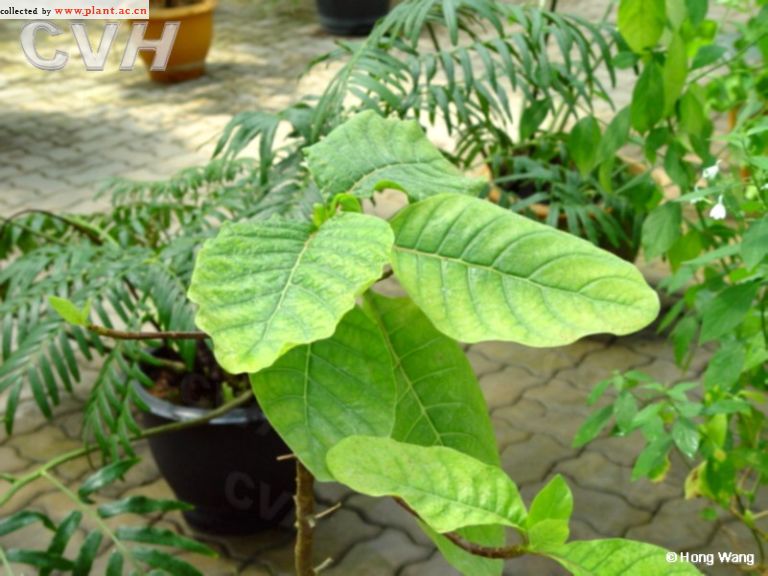鸡纳树Cinchona succirubra Pav. ex Klotzsch
鸡纳树Cinchona succirubra Pav. ex Klotzsch
2. 鸡纳树(中国树木分类学)红金鸡纳、红皮金鸡纳 图版55: 6-8
Cinchona succirubra Pav. ex Klotzsch in Abh. Akad. Berlin 60. 1857; J. H. Holland in Kew Bull. Misc. Inf. add. ser. 9: 350. 1922; 陈嵘, 中国树木分类学1131. 1937; Kirtikar et Basu, Ind. Med. Pl. 2: 1261. 1980. 云南种子植物名录, 下册: 1249. 1984.
常绿乔木,通常高3-12米;树皮灰褐色,偶有白色条痕或纵裂。叶纸质或薄革质,大而宽,卵形、卵状椭圆形或长圆形,长10-24.5厘米,宽5.5-17厘米,顶端钝,基部阔楔形或圆形,常稍下延,新鲜时在下面常呈淡红色,上面无毛,下面有疏短柔毛或近无毛;侧脉6-11对,在下面凸起;叶柄长1.5-4厘米,无毛或有短柔毛。花序腋生和顶生,长宽均可达23厘米,被淡黄色短柔毛;苞片和小苞片披针形,长约2毫米;花梗长1-3毫米;花萼长约3毫米,檐部稍扩大,裂片三角形,长0.5毫米;花冠白色或粉红色,长1-1.2厘米,冠管圆筒形,宽2-3毫米,稍具5棱,裂片卵状披针形,长约4毫米,内面边缘具淡黄色长柔毛。果近圆筒形或圆锥形,长1-1.8厘米,直径3-6毫米,有短柔毛;种子椭圆形,长4-6毫米,周围具翅。花、果期6月至翌年2月。
台湾、海南、广西南宁、云南南部有种植。原产于厄瓜多尔、秘鲁等地。印度、斯里兰卡、缅甸、菲律宾、印度尼西亚和非洲等地亦有种植。
本种奎宁含量较低;用于治疗疟疾,并有镇痛解热及局部麻醉的功用;奎宁还能增强子宫收缩,常用来引产;对于治疗疮疽、皮炎、皮癣都具有较好的疗效。另从茎皮和根皮中提制的生物碱奎尼丁可用于心房颤动阵发性心动过速和心房扑动等病症。茎皮和根皮的制剂又是苦味健胃剂和强壮药。枝、叶煎水服可退烧。
《Flora of China》 Vol. 19 (2011)
Cinchona pubescens Vahl Skr. Naturhist.-Selsk. 1: 19. 1790.
鸡纳树 ji na shu
Cinchona succirubra Pavon ex Klotzsch.
Trees and shrubs, to 12 m tall; bark grayish brown, sometimes striped with white and/or longitudinally fissured; branches somewhat flattened to subterete or angled, densely pilosulous or hirtellous to puberulent or glabrescent. Petiole 1.5-4 cm, glabrous or puberulent to hirtellous; leaf blade drying papery, ovate, ovate-elliptic, or elliptic-oblong, 10-24.5 × 5.5-17 cm, adaxially glabrous to pilosulous or puberulent, abaxially hirtellous to pilosulous or puberulent and often reddened at least when young, base obtuse to rounded or truncate, apex obtuse to rounded; secondary veins 6-11 pairs, with pilosulous domatia; stipules 10-25 mm, sparsely pilosulous, obtuse to rounded. Inflorescences 6-23 × 6-23 cm, pilosulous or hirtellous to puberulent; bracts triangular, 0.5-3 mm; pedicels 1-3 mm. Calyx with ovary portion ellipsoid, 2-3 mm, densely pilosulous; limb 1.5-3 mm, sparsely to densely pilosulous or hirtellous, shallowly lobed; lobes triangular, 0.5-1 mm. Corolla white or pink, outside glabrescent to pilosulous or puberulent; tube cylindrical, 8.5-14 mm; lobes ovate-lanceolate, 4-6 mm, acute. Capsules 10-18(-41) × 5-7 mm, pilosulous to glabrescent; seeds 7-12 × 2-3 mm (including wing). Fl. and fr. Jun-Feb.
Cultivated. Guangxi (Nanning), Hainan, Taiwan, S Yunnan [native to Central America (Costa Rica) and South America (Bolivia, Colombia, Ecuador, Peru, Venezuela); often cultivated in tropical regions worldwide].
This is the most frequently cultivated species and hybrid parent of Cinchona. It is variable morphologically in cultivation and also in its native range.This is the most frequently cultivated species and hybrid parent of Cinchona. It is variable morphologically in cultivation and also in its native range.
别名:金鸡勒;红色规那树;金鸡纳树;红色金鸡纳树;规那;红金鸡纳;红金鸡纳树;红色奎宁树;金鸡纳;奎宁树;红金鸡树;红皮金鸡纳;
科名:茜草科 Rubiaceae
属名:金鸡纳属 Cinchona

2. 鸡纳树(中国树木分类学)红金鸡纳、红皮金鸡纳 图版55: 6-8
Cinchona succirubra Pav. ex Klotzsch in Abh. Akad. Berlin 60. 1857; J. H. Holland in Kew Bull. Misc. Inf. add. ser. 9: 350. 1922; 陈嵘, 中国树木分类学1131. 1937; Kirtikar et Basu, Ind. Med. Pl. 2: 1261. 1980. 云南种子植物名录, 下册: 1249. 1984.
常绿乔木,通常高3-12米;树皮灰褐色,偶有白色条痕或纵裂。叶纸质或薄革质,大而宽,卵形、卵状椭圆形或长圆形,长10-24.5厘米,宽5.5-17厘米,顶端钝,基部阔楔形或圆形,常稍下延,新鲜时在下面常呈淡红色,上面无毛,下面有疏短柔毛或近无毛;侧脉6-11对,在下面凸起;叶柄长1.5-4厘米,无毛或有短柔毛。花序腋生和顶生,长宽均可达23厘米,被淡黄色短柔毛;苞片和小苞片披针形,长约2毫米;花梗长1-3毫米;花萼长约3毫米,檐部稍扩大,裂片三角形,长0.5毫米;花冠白色或粉红色,长1-1.2厘米,冠管圆筒形,宽2-3毫米,稍具5棱,裂片卵状披针形,长约4毫米,内面边缘具淡黄色长柔毛。果近圆筒形或圆锥形,长1-1.8厘米,直径3-6毫米,有短柔毛;种子椭圆形,长4-6毫米,周围具翅。花、果期6月至翌年2月。
台湾、海南、广西南宁、云南南部有种植。原产于厄瓜多尔、秘鲁等地。印度、斯里兰卡、缅甸、菲律宾、印度尼西亚和非洲等地亦有种植。
本种奎宁含量较低;用于治疗疟疾,并有镇痛解热及局部麻醉的功用;奎宁还能增强子宫收缩,常用来引产;对于治疗疮疽、皮炎、皮癣都具有较好的疗效。另从茎皮和根皮中提制的生物碱奎尼丁可用于心房颤动阵发性心动过速和心房扑动等病症。茎皮和根皮的制剂又是苦味健胃剂和强壮药。枝、叶煎水服可退烧。
《Flora of China》 Vol. 19 (2011)
Cinchona pubescens Vahl Skr. Naturhist.-Selsk. 1: 19. 1790.
鸡纳树 ji na shu
Cinchona succirubra Pavon ex Klotzsch.
Trees and shrubs, to 12 m tall; bark grayish brown, sometimes striped with white and/or longitudinally fissured; branches somewhat flattened to subterete or angled, densely pilosulous or hirtellous to puberulent or glabrescent. Petiole 1.5-4 cm, glabrous or puberulent to hirtellous; leaf blade drying papery, ovate, ovate-elliptic, or elliptic-oblong, 10-24.5 × 5.5-17 cm, adaxially glabrous to pilosulous or puberulent, abaxially hirtellous to pilosulous or puberulent and often reddened at least when young, base obtuse to rounded or truncate, apex obtuse to rounded; secondary veins 6-11 pairs, with pilosulous domatia; stipules 10-25 mm, sparsely pilosulous, obtuse to rounded. Inflorescences 6-23 × 6-23 cm, pilosulous or hirtellous to puberulent; bracts triangular, 0.5-3 mm; pedicels 1-3 mm. Calyx with ovary portion ellipsoid, 2-3 mm, densely pilosulous; limb 1.5-3 mm, sparsely to densely pilosulous or hirtellous, shallowly lobed; lobes triangular, 0.5-1 mm. Corolla white or pink, outside glabrescent to pilosulous or puberulent; tube cylindrical, 8.5-14 mm; lobes ovate-lanceolate, 4-6 mm, acute. Capsules 10-18(-41) × 5-7 mm, pilosulous to glabrescent; seeds 7-12 × 2-3 mm (including wing). Fl. and fr. Jun-Feb.
Cultivated. Guangxi (Nanning), Hainan, Taiwan, S Yunnan [native to Central America (Costa Rica) and South America (Bolivia, Colombia, Ecuador, Peru, Venezuela); often cultivated in tropical regions worldwide].
This is the most frequently cultivated species and hybrid parent of Cinchona. It is variable morphologically in cultivation and also in its native range.This is the most frequently cultivated species and hybrid parent of Cinchona. It is variable morphologically in cultivation and also in its native range.

